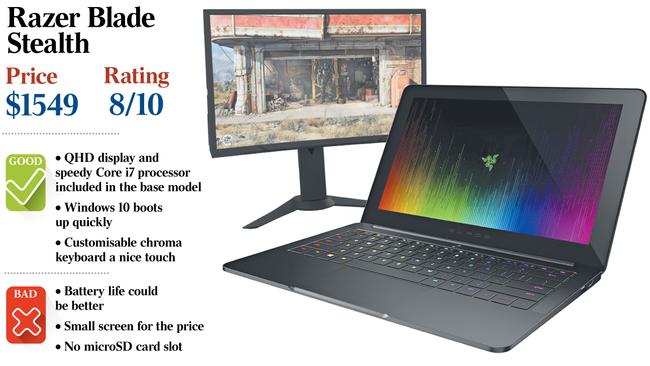Reviewed: Razer Blade Stealth, an ultra sharp signature PC
Loaded with premium gear, this is one laptop that offers maximum bang for the buck and is anything but boring.

Razer is a name synonymous with some of the fastest gaming laptops in the market and now it’s turned its attention to the ultraportable market with the Razer Blade Stealth. As a high-end ultrabook, the Stealth ticks all the boxes but it also serves up some unique ideas of what a super light notebook can be.
The first thing that strikes you is its distinctive matt black metal unibody shell, rigid construction with zero signs of flex, minimalist design and glowing three-snake emblem. It’s a slick looking machine that’s impeccably built and feels durable. Little details such as a solid hinge means you can use the touchscreen with little screen wobble and comfortably open the notebook with one hand. My only complaint is that the bezels around the 12.5-inch display are thick and give the Stealth a somewhat dated feel. Razer could have easily squeezed in a 13-inch panel into this notebook had it slimmed down the borders. The Stealth’s nearest competitor, the Dell XPS 13, fits a 13.3-inch display into the size of an 11-inch laptop thanks to a near bezel-less design.
At 1.25kg, it’s not as light as Apple’s MacBook (920g) or HP Spectre 13 (1.11kg), but it does boast a significantly faster processor (Intel Core i7-6500U) than either of those machines and is also thinner and lighter than its direct competitors, the XPS 13 and Macbook Air. It also has a healthy smattering of ports, including a full-size HDMI 1.4 (not 2.0, unfortunately), two USB 3.0 ports and a USB-C port that can be used to connect to external monitors and charging duties through the compact included AC adaptor. Noticeably absent is an SD-card slot.
Crucially, the USB-C port can also be used to connect to an external GPU box called the Razer Core (sold separately for $US499, or $657), which gives the Stealth access to desktop-class graphics, effectively turning it into a potent gaming PC. The Core also adds more ports to the equation, such as gigabit ethernet. The likes of Alienware and Asus offer similar attachments, but Razer’s solution is the best of the bunch and requires only one USB-C cable connection to work (that single wire will also handle power duties).
If you do plan on going down the external GPU route, keep in mind that dual core processors such as the one found in the Stealth and in most ultrabooks can bottleneck some high-end graphics cards for CPU-intensive games. The new Doom reboot, for example, requires a quad-core CPU. The Core accessory wasn’t available at the time of this review so we’ll have to reserve our judgment on its gaming potential.
While you won’t be playing the latest triple-Atitles with Intel’s 520 integrated graphics, it’s fine for most indie games such as The Witness and streaming Xbox One games to the Stealth also works without a hitch.
The 12.5-inch QHD (2560 x 1440) display is gorgeous and has great viewing angles and contrast. It’s a glossy screen, but bright enough to compensate for most reflections and coped well outdoors during testing. Bizarrely, there’s no auto-brightness sensor on-board so you will need to manually adjust the screen brightness. The Stealth can be configured up to a 4K resolution display.
The base configuration comes with 128GB of storage, 8GB of RAM and the aforementioned Core-i7 processor and QHD display.
Storage can be upgraded fairly easily by popping open the back but the RAM is soldered on to the motherboard and isn’t upgradeable. That said, unless your typical workflow includes regular video and photo editing, the Stealth’s base configuration is more than adequate for most tasks.
Two areas where PC makers usually disappoint is the amount of bloated software they include with Windows 10 and an inconsistent trackpad. Thankfully, Razer rewrites the script on both fronts. Out of the box, the relatively large glass trackpad felt sluggish but cranking up the sensitivity in the settings made it a lot faster to use. There were no cursor skips and gestures worked every time. It’s not as fast or responsive as the Macbook’s touchpad, but this is about as good as it gets in the Windows world.
On the software side, Razer includes Synapse for customising the keyboard lighting, as well as its Comms software. Other than that, the only other software installed is Dolby Digital audio manager. You won’t find useless antivirus trials and other crapware typically loaded on by PC manufacturers. This is as close to a signature PC as you’re going to get from any OEM, so hats off to Razer.
The Stealth is the first notebook to have individual backlit RGB keyboard that allows you to assign each key to 16.8 million different colour options. You can, for instance, choose to illuminate the top row of function keys a different colour or highlight the all-important WASD keys for gaming. Alternatively, you can choose from a number of lighting presets, some of which are impressive such as the Wave mode, where a rainbow of colours will move rapidly left to right across the entire keyboard. It’s a bit gimmicky but it does offer a unique level of personalisation.
Unfortunately, the battery life wasn’t able to get us through a full work day, clocking in at around 6.5 hours with the screen brightness set to 50 per cent. It’s above the ultrabook average, but below the likes of the XPS 13 and Macbook.
At $1549, the Razer Blade Stealth offers a slick package that is excellent value for money. While we would’ve like to have seen longer endurance in the battery life department, you won’t find a better built Windows ultraportable for the price.


